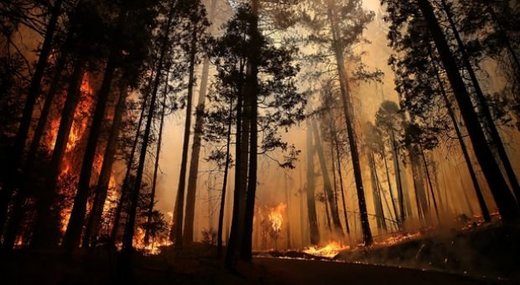Since 2010 and the beginning of the California drought, the number of dead trees in the central and southern Sierra Nevada has reached a conservative 66 million by some estimates. According to scientists, there are several factors at play causing the devastation of the forests and contributing to an increasingly dire fire hazard.
The intense ongoing drought in California is contributing to the Sierra Nevada forest deadfall. Also, global warming has led to warmer winters that no longer balance a growing bark beetle population devastating conifers in the mountains. Finishing the job, fungi and a foreign-borne plant pathogen brought to California through global trade are affecting moist areas where oaks and other deciduous trees grow. The human factor worsens the situation as a lack of forest management, especially in the clearing of combustible dead wood, has exacerbated an already gloomy forecast.
As David Rizzo, chairman of plant pathology at the University of California, Davis, stated,
"It's never just one thing that brings down trees. It's always a combination. The first may weaken trees; the next stresses trees over time. Then comes a third, shutting down the trees' immune and defense systems. Finally, the last may come along to disrupt nutrient systems. When all this happens at once, or in rapid succession, trees are no longer able to save themselves."Rizzo and Matteo Garbelotto, a professor of environmental science policy and management at the University of California, Berkeley, have been conducting long-term research, and have discovered that widespread conifer loss is largely attributed to a fungus-like pathogen that infected deciduous trees years before they fell. "Phytophthora ramorum is the cause of both Sudden Oak Death, a forest disease that has resulted in widespread dieback of several tree species in California and Oregon forests, and Ramorum blight, which affects the leaves and twigs of numerous other plants in forests and nurseries," according to the suddenoakdeath.org website.
The source of the disease is not known but is believed to be spread by rain splash. The pathogen is hosted by the bay laurel tree, a plant that does not succumb to the disease. But the bay laurel then infects neighboring oaks and tanoaks through rain droplets running off its leaves. The pathogen pours into the tree and leaves lethal spores that rob the tree of nutrients. Fungi and pests soon follow, as the tree has been weakened, soon dying, in as little as two years. As long as tanoaks spread the pathogen, sudden oak death will follow.
Coastal residents of California are working toward eliminating the problem, seeking signs of disease, collecting samples and sending them to laboratories. But a cure is far from guaranteed.
The number of dead trees in Sierra Nevada and the Lake Tahoe Basin is likely to grow. According to the New York Times, "Neither of the two enormous die-offs seems to be ending anytime soon, and the Big Sur blaze is still burning — with more than 90,000 acres destroyed."
As US Agriculture Secretary Tom Vilsack put it earlier this summer,
"Tree die-offs of this magnitude are unprecedented and increase the risk of catastrophic wildfires that put property and lives at risk. We must fund wildfire suppression like other natural disasters in the country."




Reader Comments
to our Newsletter